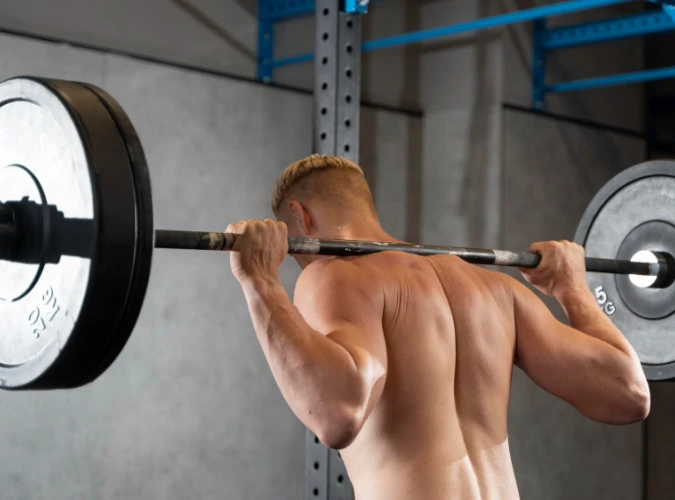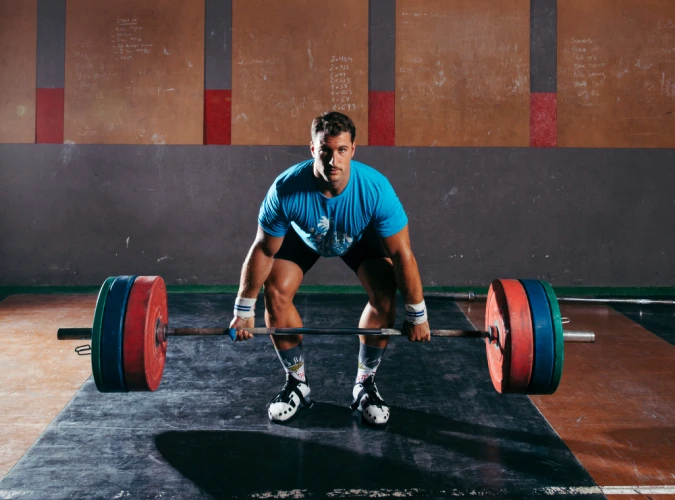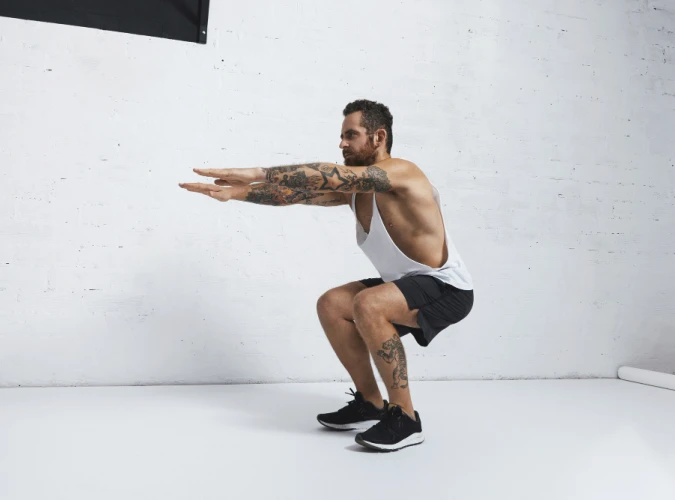Unlocking Glute Gains: Healthovia's Best Exercises
Unlocking Glute Gains: Healthovia's Best Exercises
The gluteus maximus is the largest muscle in the body and plays a crucial role in overall lower body strength and stability. Whether you're an athlete looking to enhance performance or simply want to achieve a stronger, shapelier booty, incorporating effective glute exercises into your workout routine is key.

Healthovia, in collaboration with fitness experts Austin Current and Jake Dickson, has compiled a list of the best glute exercises that can help you unlock your glute gains. These exercises have been carefully selected based on their ability to target and engage the glute muscles effectively, leading to optimal growth and strength.
Key Takeaways:
Strengthening the glutes is crucial for maximizing performance in various exercises.
Healthovia's experts recommend a combination of compound exercises and unilateral leg training to target the glutes effectively.
Proper form and appropriate weight selection are essential for optimal glute development.
Incorporate the recommended glute exercises into your workout routine for significant glute gains.
Consistency and progressive overload are key to achieving a stronger and shapelier booty.
Conventional Deadlift
The conventional deadlift is hailed as the king of all deadlift variations, and for a good reason. This compound exercise targets the glutes while focusing on hip extension, making it an excellent addition to any glute workout routine. By engaging various muscles, including the glutes, the conventional deadlift promotes strength training and overall lower body development.
"The conventional deadlift is a staple in strength training programs. It challenges the posterior chain, including the glute muscles, and helps build overall strength and power." - Austin Current, Fitness Expert
To perform the conventional deadlift, begin with a hip-width stance, ensuring that the barbell is placed just outside your shins. Maintaining a flat back, hinge forward at the hips, and grab the barbell with an overhand grip. From this starting position, push into the floor with your legs, engaging your glutes, and lift the barbell, bringing your hips forward until you reach a standing position.
To maximize glute growth and strength, aim for 3-4 sets of 5-8 reps during your conventional deadlift sessions. Remember, proper form and technique are essential to prevent injury and ensure optimal glute engagement.
Back Squat
The back squat is a compound exercise that targets multiple muscles in the legs, including the glute muscles. It is a highly effective exercise for building leg strength and promoting muscle growth. Performing the back squat properly can challenge hip extension and engage the glutes to a significant extent.
To perform the back squat, follow these steps:
Start by unracking a barbell from a squat rack, positioning it on your upper back with a close grip.
Stand with your feet shoulder-width apart and toes slightly turned out.
Lower your body by bending at the knees and hips, as if sitting back into a chair. Keep your chest up and your core engaged.
Squat down as low as you can while maintaining good form. Aim for thighs parallel to the ground or slightly below.
Push through your heels and extend your hips and knees to return to the starting position.
When performing the back squat, it's essential to maintain proper form and control throughout the movement. This exercise can be demanding, so start with a weight that challenges you without sacrificing form. Aim for 3-4 sets of 6-8 reps with a challenging weight to effectively engage the glutes and maximize leg strength.
The back squat is a versatile exercise that can be modified with different stances or equipment variations to target specific areas of the glutes or legs. Incorporating the back squat into your workout routine regularly can lead to significant improvements in glute strength, leg power, and overall lower body development.
Hip Thrust
The hip thrust is a highly effective exercise for targeting the gluteus maximus, one of the largest muscles in the body. Unlike glute bridges on the floor, the hip thrust allows for a greater range of motion, making it an excellent choice for glute development.
To perform the hip thrust, start by sitting with your upper back against a weight bench. Place a loaded barbell on your hip crease, just below your pelvis. With your feet planted firmly on the ground and your knees bent, initiate the movement by pushing your hips upward, squeezing your glutes at the top of the motion. Lower your hips back down in a controlled manner and repeat for the desired number of reps.
To achieve optimal results, aim for 4-5 sets of 8-12 reps of hip thrusts in your glute workout routine. Gradually increase the weight as you become stronger and more comfortable with the movement, but always prioritize proper form to avoid injury.
The Benefits of Hip Thrusts
Hip thrusts offer several benefits for glute development and overall lower body strength. Here are some key advantages of incorporating hip thrusts into your fitness routine:
Targeted Glute Activation: Hip thrusts specifically target the gluteus maximus, helping to build strength, size, and shape in the glute muscles.
Increased Range of Motion: Compared to glute bridges on the floor, hip thrusts allow for a greater range of motion, promoting full activation and engagement of the glutes.
Spine-Friendly Exercise: The hip thrust places the load on the hips and glutes, rather than the spine, reducing the risk of lower back strain or injury.
Improved Hip Extension: Hip thrusts effectively train hip extension, a fundamental movement pattern that supports various athletic activities and exercises.
"The hip thrust is a must-have exercise for anyone looking to strengthen and shape their glutes. It not only targets the gluteus maximus effectively but also offers a greater range of motion compared to other glute exercises." - Austin Current, Fitness Expert
When combined with other glute exercises, such as the conventional deadlift and back squat, hip thrusts can help you achieve a well-rounded glute workout routine. Consistency and proper form are key to seeing significant results in glute development. So go ahead, add hip thrusts to your routine, and unlock your glute gains!
Belt Squat
The belt squat is a highly effective exercise for targeting the glutes while promoting a more vertical spine and minimizing strain on the lower back. This exercise involves standing on a platform and securing a belt around your hips, which is then attached to a pulley system. As you squat down, the pulley system guides your movement, allowing for a controlled and focused glute activation.
The advantage of the belt squat is that it allows you to increase your training volume without putting excessive load on the lumbar spine. The more vertical spine position lessens the stress on the lower back while still effectively engaging the glute muscles. This is particularly beneficial for individuals with lower back issues or those seeking to minimize the risk of injury.
When performing the belt squat, aim for 2-3 sets of 8-12 repetitions with a moderate weight. This rep range and volume will help you effectively target and engage the glute muscles, promoting growth and strength development. Remember to maintain proper form throughout the exercise by keeping your core engaged and focusing on the hip hinge motion.
Belt Squat Benefits:
Allows for a more vertical spine position, reducing strain on the lower back
Increases training volume for enhanced glute activation and development
Minimizes load on the lumbar spine, making it suitable for individuals with lower back issues
Promotes proper form and technique for optimal glute engagement

"The belt squat is an excellent exercise for targeting the glutes while maintaining a more vertical spine. It allows for increased training volume without compromising the lower back." - Fitness expert Austin Current
Banded Romanian Deadlift
The banded Romanian deadlift is a variation of the Romanian deadlift that adds resistance to the movement using a resistance band. This exercise is highly effective for targeting the glute muscles and improving hip-hinging abilities.
To perform the banded Romanian deadlift, begin by wrapping the resistance band around your hips and hold a barbell with an overhand grip. Stand with your feet shoulder-width apart and slightly bend your knees. Next, hinge at the hips, pushing them back while maintaining a flat back and letting the band pull your pelvis backward. Lower the barbell toward your shins while keeping it close to your body. Once you feel a stretch in your hamstrings, engage your glutes and thrust your hips forward to return to a standing position.
Aim for 2 sets of 12-15 reps with a moderate weight to effectively engage the glutes and improve hip-hinging abilities. Remember to maintain proper form throughout the exercise to avoid injury and optimize results.
Fitness expert Jake Dickson recommends adding resistance bands to traditional exercises like the Romanian deadlift to intensify the glute engagement and enhance hip-hinging abilities.
Rear Foot Elevated Split Squat
The rear foot elevated split squat is a fantastic glute exercise that targets the glutes while also providing unilateral leg training and improved balance. This exercise isolates one leg at a time, allowing for greater glute activation and the opportunity to improve glute size and strength.
To perform the rear foot elevated split squat, start by placing your non-working leg on a knee-height bench or box. With a weight in each hand, balance yourself on your working leg and sink your hips down and back, ensuring your front knee stays in line with your toes. Push back up to a standing position, using your glute muscles to drive the movement.
This exercise specifically targets the glute of the front leg, as the elevated position of the back leg encourages greater glute engagement. It's essential to maintain proper form throughout the exercise, ensuring your front knee stays in line with your toes and your back remains straight.
Aim to incorporate 2-3 sets of 8-12 reps of the rear foot elevated split squat into your lower body workout routine. Use proper form and choose the heaviest weight you can maintain with good technique to effectively target and strengthen your glutes.
This exercise is not only beneficial for glute development but also helps improve balance and stability. Incorporating the rear foot elevated split squat into your workout routine can contribute to a well-rounded lower body training program.
Benefits of Rear Foot Elevated Split Squat:
Greater glute activation
Improved glute size and strength
Unilateral leg training
Enhanced balance and stability
Proper Form Tips:
Place your non-working leg on a knee-height bench or box
Balance yourself on your working leg
Sink your hips down and back
Keep your front knee in line with your toes
Push back up using your glute muscles

"The rear foot elevated split squat is a fantastic glute exercise that not only targets the glutes but also helps improve balance and stability." - Austin Current
Sumo Deadlift
The sumo deadlift is a highly effective glute exercise that targets the lower body, particularly the glute medius and minimus. This exercise, characterized by a wide stance and toes turned out, places significant tension on the glute muscles and allows for a more upright torso, reducing strain on the lumbar spine.
To perform the sumo deadlift:
Stand with your feet wider than shoulder-width apart, toes pointed outwards.
Position yourself behind the barbell, ensuring it is centered between your feet.
With a firm grip and your hands inside your legs, hinge at the hips and lower into a squat position.
Drive through your heels and push into the floor to lift the barbell, extending your hips and standing upright.
The sumo deadlift is known for its ability to develop lower body strength, particularly in the glutes. Aim to perform 3-4 sets of 3-6 reps, using a heavy weight that challenges your muscles and promotes growth.
Benefits of Sumo Deadlift:
Targets the glute medius and minimus for enhanced glute development.
Promotes lower body strength and stability.
Allows for a more upright torso, reducing strain on the lower back.
Challenge yourself with the sumo deadlift to engage your glutes and achieve a stronger lower body.
Walking Lunge
The walking lunge is a highly effective glute exercise that mimics the natural gait of walking and specifically targets the glute muscles. This exercise not only helps to strengthen and tone the glutes but also promotes stability and improved functional movement of the hips and pelvis.
To perform the walking lunge, start by standing upright with your feet shoulder-width apart. Take a step forward with one leg, then lower your body by bending both knees until the front thigh is parallel to the floor. Push off with the front leg, bring the back leg forward, and repeat the movement with the opposite leg.
Engaging in walking lunges helps activate multiple muscles in the lower body, including the glutes, quads, and hamstrings. Additionally, this exercise offers an aerobic component, making it a great choice for incorporating cardiovascular conditioning into your workout routine.
Aim to perform 3 sets of 6-8 reps per leg, gradually increasing the number of reps over time as your glute strength and stability improve. Remember to maintain proper form throughout the exercise, keeping your chest lifted, core engaged, and knees aligned with your ankles.
Focus on the lower half of the body, showcasing toned legs and glutes. The subject is performing a walking lunge with perfect form, emphasizing the contraction in the glutes and quads. The background is a spacious gym, with weights and exercise equipment visible in the distance to give a sense of an active workout environment. The lighting is bright and vibrant, highlighting the muscular definition in the legs and backside.
Benefits of Walking Lunge:
Targets the glute muscles for improved strength and toning
Promotes stability and functional movement of the hips and pelvis
Engages multiple lower body muscles, including the quads and hamstrings
Provides an aerobic component for cardiovascular conditioning
"The walking lunge is a versatile exercise that can be easily incorporated into any workout routine for optimal glute activation and overall lower body development." – Austin Current, Fitness Expert
Single-Leg Deadlift
The single-leg deadlift is a highly effective glute exercise that focuses on unilateral leg training and stability. By working the glute maximus and medius, this exercise not only strengthens the glutes but also improves overall strength and mobility.
To perform the single-leg deadlift, start by standing on one leg with the other leg slightly back. Next, hinge forward from the hips while keeping the back straight and the core engaged. As you lower the torso, lift the back leg straight back until both the torso and leg are parallel to the ceiling. Maintain control and stability throughout the movement.
Aim to incorporate 3-4 sets of 8-12 reps per leg into your workout routine to effectively target the glutes and reap the benefits of unilateral leg training. This exercise enhances stability and helps correct any muscle imbalances between the left and right leg.
By including the single-leg deadlift in your glute exercises routine, you can strengthen your glute muscles and improve overall lower body function. Unilateral leg training not only enhances stability but also helps achieve better muscle symmetry.
Conclusion
Strengthening your glutes is essential for maximizing performance in a wide range of exercises and improving overall lower body strength. Healthovia presents a curated selection of the best glutes exercises that can help you unlock your glute gains and achieve a stronger, shapelier booty.
By incorporating these effective glutes exercises into your regular workout routine, using proper form and appropriate weight, you can experience significant glute development and enhanced strength. Whether you choose to include the conventional deadlift, back squat, hip thrust, or other expert-recommended exercises, Healthovia's best glutes exercises can pave the way for your glute transformation.
Don't wait any longer to start your glute workout journey. Begin today with Healthovia's expert-picked best glutes exercises and discover the remarkable benefits of a well-trained gluteus maximus. Your future self will thank you for the effort and dedication toward achieving stronger, firmer, and more powerful glutes.
FAQ
What are the best glutes exercises recommended by Healthovia?
Healthovia recommends 16 top glute exercises, including the conventional deadlift, back squat, hip thrust, belt squat, banded Romanian deadlift, rear foot elevated split squat, sumo deadlift, walking lunge, cable glute kickback, step-up, Smith machine reverse lunge, lateral lunge, goblet squat, single-leg glute bridge, good morning, and kettlebell swing.
How do I perform the conventional deadlift to target my glutes?
To perform the conventional deadlift, start with a hip-width stance, grab the barbell just outside your shins, flatten your back, and lift the barbell by pushing into the floor with your legs. Aim for 3-4 sets of 5-8 reps to promote glute growth.
How does the back squat target the glutes?
The back squat is a compound exercise that targets multiple muscles in the legs, including the glutes. To perform the back squat, unrack a barbell from a squat rack, place it on your upper back with a close grip, and squat down as low as you can while maintaining good form. Aim for 3-4 sets of 6-8 reps with a challenging weight to effectively engage the glutes.
What is the hip thrust and how does it target the glutes?
The hip thrust is a glute exercise that effectively loads the glutes in their shortened position without loading the spine. To perform the hip thrust, sit with your upper back against a weight bench, place a loaded barbell on your hip crease, and initiate the thrust by pushing your hips upward. Aim for 4-5 sets of 8-12 reps to target and grow your glutes.
How does the belt squat engage the glutes while minimizing strain on the lower back?
The belt squat is an exercise that allows for a more vertical spine and increased training volume without excessive strain on the lower back. To perform the belt squat, stand on a platform, fasten a belt around your hips, and squat down while allowing the pulley to guide your movement. Aim for 2-3 sets of 8-12 reps with a moderate weight to effectively engage the glutes and minimize load on the lumbar spine.
What is the banded Romanian deadlift and how does it target the glutes?
The banded Romanian deadlift is a variation of the traditional Romanian deadlift that adds resistance to the movement using a resistance band. To perform the exercise, wrap the resistance band around your hips, hold a barbell, hinge at the hips, and thrust your hips forward to return to a standing position. Aim for 2 sets of 12-15 reps with a moderate weight to effectively engage the glutes.
How does the rear foot elevated split squat target the glutes?
The rear foot elevated split squat is a unilateral leg exercise that isolates one leg at a time, allowing for greater glute activation and improvement in size and strength. To perform the exercise, balance yourself on your working leg with a weight in each hand and sink your hips down and back, then push back up to a standing position. Aim for 2-3 sets of 8-12 reps with proper form and the heaviest weight you can maintain to target the glutes effectively.
How does the sumo deadlift engage the glutes?
The sumo deadlift is a widely used glute exercise that targets the lower body, particularly the glute medius and minimus. To perform the sumo deadlift, take a wide stance, point your feet towards the weight plates, grab the barbell, and stand up by pushing into the floor with your legs. Aim for 3-4 sets of 3-6 reps with a heavy weight to effectively engage the glutes.
How does the walking lunge target the glutes?
The walking lunge is an exercise that mimics the gait and targets the glutes to support movements of the hips and pelvis. To perform the exercise, step forward with one leg and bend both knees to lower into a lunge, then push off with the front leg to return to a standing position. Aim for 3 sets of 6-8 reps per leg to engage the glutes and improve stability.
How does the single-leg deadlift target the glutes?
The single-leg deadlift is a glute exercise that targets unilateral leg strength and stability. To perform the exercise, start standing on one leg with the other leg slightly back, hinge forward, lift the back leg straight back, and lower the torso until both are parallel to the ceiling. Aim for 3-4 sets of 8-12 reps per leg to target the glutes effectively.
Why are glutes exercises important for strength and development?
Strengthening the glutes is crucial for maximizing performance in various exercises and improving overall lower body strength. Healthovia's selection of top glute exercises can help individuals unlock their glute gains and achieve a stronger, shapelier booty.



